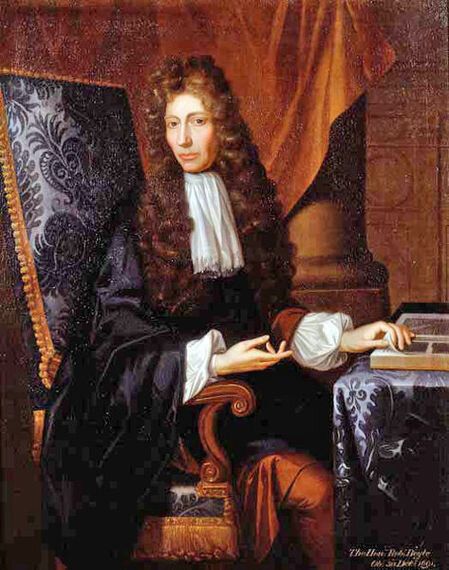Be honest: did you once believe that spaghetti could grow on trees? That cats needed headphones? Or that the moon was made of cheese? Actually, don't worry about that last one; I'm still sure that's true. However embarrassingly you may have been hoodwinked on April Fool's Day in the past, it is incredibly unlikely that you'll have ever been swindled by French confidence trickster Georges Pierre des Clozets, who represented a completely fictional secret Alchemy society called 'The Asterism'. That dubious honour fell to Robert Boyle, philosopher, chemist, physicist, and inventor, who was duped in the latter part of the 17th century.
Between 1677 and 1678 Robert Boyle became the victim of a progressive French confidence trickster from Caen called Pierre, who claimed to be the agent of a secret international society of alchemists known mysteriously as 'The Asterism'. The leader of The Asterism was described as the 'Patriarch of Antioch', resident in Constantinople. Pierre claimed to be able to work as an intermediary between Robert Boyle and the head of this exclusive society, Georges du Mesnillet, who Pierre referred to as the Patriarch of Antioch. The Asterism was, allegedly, a society comprised of the leading alchemists from around the world, a society that held the secrets to the riddles that had notoriously plagued Robert Boyle throughout his career. Pierre promised that Boyle would be made a member of The Asterism and, therefore, be privy to these alchemical secrets if he followed his orders.
There were a few problems with this. Firstly, The Asterism was an entirely fictional society made up by Pierre. Secondly, Georges du Mesnillet was not the Patriarch of Antioch (nor was there ever a French Patriarch of Antioch). Georges du Mesnillet was just an old acquaintance of Pierre's. And thirdly, many of the alchemical secrets Pierre promised to impart were chemically impossible. Of course, Robert Boyle wasn't to know any of this. Pierre expertly played on Robert Boyle's obsessive fascination with alchemy, and toyed with Boyle's perception of what was plausible and, more importantly, what was implausible. At one point during their correspondence, Pierre even managed to convince Boyle that one of the Chinese members of the society based in France had grown a fully formed homunculus in a jar.

So how did Pierre manage to successfully dupe the otherwise incredibly intelligent Robert Boyle?
As well as making a good personal impression on Boyle when the two met in early 1677 - Pierre is alluded to as the 'illustrious stranger' and 'foreign virtuoso' in Boyle's An Historical Account of a Degradation of Gold by an Anti-Elixir - the French conman manipulated leading European periodicals to corroborate his fanciful tale. For instance, the stories Pierre told Boyle, such as the Patriarch of Antioch working towards the "reunification of the Greek and Latin Churches", were backed up in France's Mercure Galant and Holland's Haerlemse Courant. The latter was published by Haarlem printer Abraham Casteleyn and it had an excellent reputation for reliability, and for acquiring sensitive international information ahead of its rivals. We also know that Robert Boyle read this publication during the years that Pierre fed 'information' to the publishers, and that Boyle was an irenic Christian, so these stories would have appealed to him and helped him believe the lies Pierre was telling him. The artifice of Pierre was such that he made Boyle trust him implicitly.
In early 1678 Robert Boyle was promised by Pierre that a triple-locked chest containing the alchemical secrets of The Asterism would be delivered to him as his membership had been approved by the (pseudo) Patriarch of Antioch. It was at this point that Pierre's letters to Boyle started to dry up. Pierre's silence was only punctuated by his bizarre excuse that the delays were due to a freak canon accident that had resulted in him breaking his lower jaw bone and losing part of his forehead. Needless to say, this triggered Boyle's long overdue scepticism, and soon he found out the embarrassing nature of his correspondence with Pierre and the fictional society of The Asterism.
This embarrassing episode did not just impact on Robert Boyle's pride, but his bank balance too. Pierre, and the fictional Patriarch of Antioch, swindled Robert Boyle to the tune of several hundred pounds worth of gifts. Amongst many other things, here are a few items Robert Boyle sent Pierre, on the 'request' of the Patriarch of Antioch: a telescope, assay balances, a globe, one hundred glass vials, jackets of fine fabric, eight rods of gold-coloured moiré, and a chiming clock over three feet tall. The only gift that we can be sure Boyle received in return, based on the correspondence between them, was a basket of fruits and cheeses. I think it's fairly obvious who came out on top of that exchange.
Pierre used the gifts and money he had received from Robert Boyle, and numerous other victims throughout the 1670's, to purchase an extravagant estate in Bretteville in the spring of 1680. While building and planting on the site, Pierre became ill with inflammation of the lung and died in May 1680. His family inherited the estate and the missive that announced his death summed up his mysterious existence perfectly: "Such was the end of this man, whose character had been so little known, and after his death we know even less than when he was alive".
Electronic Enlightenment currently has 13 letters from Georges Pierre Des Clozets to Robert Boyle written in French, along with their English translations. Electronic Enlightenment is a scholarly research project of the Bodleian Libraries, University of Oxford, and is available exclusively from Oxford University Press. It is the most wide-ranging online collection of edited correspondence of the early modern period, linking people across Europe, the Americas, and Asia from the early 17th to the mid-19th century.
Image credit: Robert Boyle by Johann Kerseboom via Wikimedia Commons.
This article was originally posted on the OUPblog here.